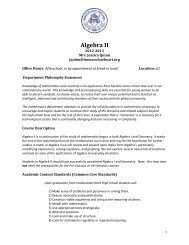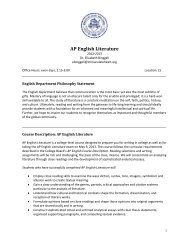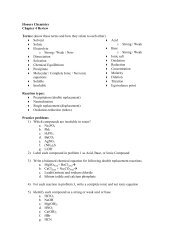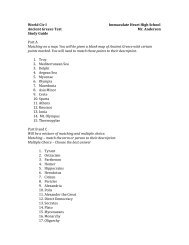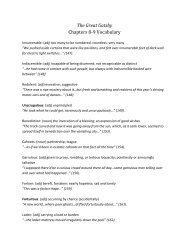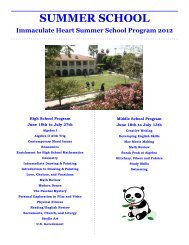ZOO PROJECT - Immaculate Heart High School
ZOO PROJECT - Immaculate Heart High School
ZOO PROJECT - Immaculate Heart High School
You also want an ePaper? Increase the reach of your titles
YUMPU automatically turns print PDFs into web optimized ePapers that Google loves.
<strong>ZOO</strong> <strong>PROJECT</strong><br />
NAME: _________________________DATE: ________PERIOD: __________TEACHER:____________________<br />
On Wednesday February 9 th , you will join your fellow classmates in biology on an all day<br />
safari at the Los Angeles Zoo. Upon arriving at the zoo, you will take a self-guided tour. I<br />
encourage you to take notes as you go on this tour. Your notes may come in handy when<br />
you sit down to begin your project. Do not lose this handout! You will turn it in at the end<br />
of the day! After your tour, you will be on your own to complete the other activities in this<br />
packet. Please make sure that you are in groups of 3-4 at all times (p.s. you are turning in<br />
your own project)! Never lose sight of a group member and never travel alone or in pairs.<br />
Please be on your best behavior and under no circumstances are you to feed the animals. You<br />
will report back to the front of the zoo at 2:25pm.<br />
<strong>ZOO</strong> ACTIVITIES OUTLINE<br />
Scavenger Hunt<br />
Animal Observations (2)<br />
<strong>ZOO</strong> <strong>PROJECT</strong> (INDEPENDENT) OUTLINE<br />
Glog (Online Interactive Poster)<br />
Scavenger Hunt (30 points):<br />
Find 10 different animal species and complete the following table. You have been given<br />
some clues!<br />
Common<br />
Name<br />
1 double<br />
wattled<br />
cassowary<br />
Scientific<br />
Name<br />
Habitat<br />
Type<br />
rainforest<br />
Habitat<br />
Location<br />
Adaptations<br />
Observations<br />
2 Mandrillus<br />
sphinx<br />
omnivorous<br />
1
3 mangroves<br />
scrub<br />
coastal dunes<br />
grasslands<br />
Aldabra Atoll<br />
Seychelles<br />
Islands<br />
Indian Ocean<br />
4 brown pelican pouch<br />
5 Capra nubiana rugged desert<br />
precipitous<br />
cliffs<br />
6 South Eastern<br />
US Texas,<br />
Louisiana,<br />
Mississippi,<br />
Alabama,<br />
Georgia,<br />
Florida<br />
7 slow loris Nycticebis<br />
coucang<br />
ectothermic<br />
“cold<br />
blooded”<br />
8 Tauraco<br />
leucolophus<br />
9 thorn scrub<br />
deciduous<br />
forest<br />
copper<br />
pigments<br />
red turacin<br />
and green<br />
turacoverdin<br />
white and<br />
yellow stripes<br />
scaly skin<br />
10 Island fox Channel<br />
Islands<br />
California<br />
2
Glog (Online Interactive Poster) (150 points):<br />
You are now a zoologist working to create an online interactive poster that documents<br />
interesting facts about an animal you observe and study at the zoo. You will observe and<br />
study two animals of three that are assigned to you and upon your return to the lab, create a<br />
Glog of only one animal (your choice between your two observed animals).<br />
My Assigned Animals<br />
Number: _______ Animal Name: ________________________________<br />
Number: _______ Animal Name: ________________________________<br />
Number: _______ Animal Name: ________________________________<br />
At the Zoo: (40 points…20 per animal)<br />
For each of your animals, spend a minimum of 15 minutes observing a single individual or a<br />
group of individuals. Take very detailed notes about their behavior and other facts posted by<br />
the exhibit. It is important that you concentrate on your observations. While observing<br />
your animal take pictures of the animal and record video footage using a camcorder, digital<br />
camera or a cell phone with video capabilities.<br />
Back at the Lab: (110 Points)<br />
You will be creating a Glog (Online Interactive Poster) depicting one animal of two that you<br />
observe at the zoo. This interactive poster is similar to a page in a scrapbook. It gives you the<br />
opportunity to share information about a topic in a fun and creative way. You will include<br />
text, as well as photos and video footage. Thefollowing information must be included (you<br />
may bullet point your information):<br />
COMMON NAME (Genus species)-By (Your Name)<br />
1. Taxonomy (kingdom, phylum, class, order, family, genus species).<br />
Make sure that you include the common name and the scientific name (Genus<br />
species). (A list is preferred)<br />
2. Pictures (2 Minimum) and Video Footage (2 minute minimum/3minute<br />
maximum)<br />
Include 1 photograph YOU TOOK AT THE LA <strong>ZOO</strong> AND include 1<br />
photograph from the web. Include video footage of your animal engaging in<br />
unique behavior.<br />
***Note: Use a camera or camera phone that you have had success<br />
downloading the pictures/video footage off of in the past…test this out<br />
before going to the zoo!!***<br />
3
3. Direct Observation<br />
Summarize your DIRECT observations from the zoo. Describe in detail the<br />
behaviors you observed while at the zoo.<br />
4. Habitat /niche<br />
Describe where your animal lives (desert, rainforest, mountains, grasslands,<br />
etc).<br />
5. Feeding<br />
What does your animal eat? Does it do anything special with respect to<br />
foraging, hunting, or eating?<br />
6. Reproduction<br />
How does your animal find/court a mate? How long is gestation? # of<br />
offspring? Are parental roles established in the caring of offspring? Etc.<br />
7. Behavior<br />
Does your animal have any unique behaviors? If so, what are they and why are<br />
they important?<br />
8. Adaptations<br />
What characteristic(s) does this species possess to help it survive in its<br />
environment? (physical and behavioral)<br />
9. Conservation status<br />
Is this animal listed as endangered or threatened? What factors are impacting<br />
the population of this species? (i.e. over hunting, habitat loss, etc.) What<br />
efforts are being made to conserve this species?<br />
10. Links<br />
Provide 3 links to other RESPECTABLE (no Wiki!) websites to find out more<br />
about the species.<br />
NOTE: This packet (notes, scavenger hunt and 2 animal observations) are due as you board<br />
the bus to return to school.<br />
THIS <strong>PROJECT</strong> IS WORTH 180 POINTS<br />
DUE DATE: February 28, 2011<br />
KEY:<br />
180-162 A IF YOU NEED HELP, PLEASE ASK!<br />
161-144 B<br />
143-126 C GOOD LUCK!!!<br />
125-108 D<br />
107-0 F<br />
4
Animal 1:<br />
Date: ___________________ Time End: ___________________<br />
Location: ___________________ Common Name: ___________________<br />
Weather: ___________________ Scientific Name: ___________________<br />
Time Start: ___________________<br />
Notes on behavior:<br />
5
Animal 2:<br />
Date: ___________________ Time End: ___________________<br />
Location: ___________________ Common Name: ___________________<br />
Weather: ___________________ Scientific Name: ___________________<br />
Time Start: ___________________<br />
Notes on behavior:<br />
6



